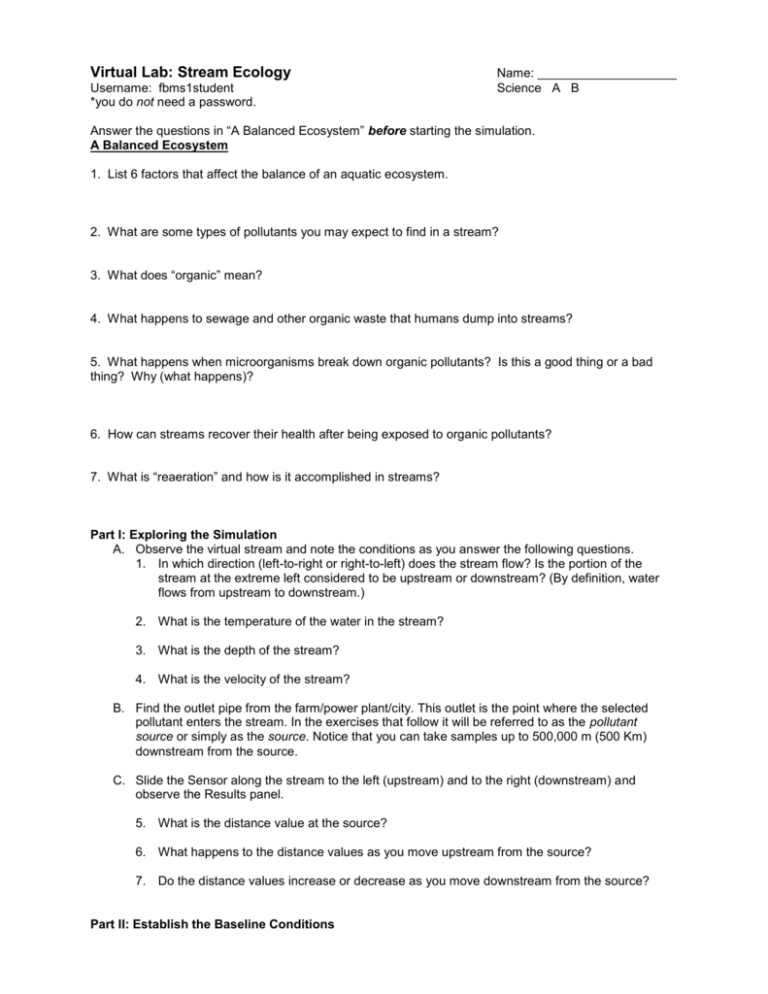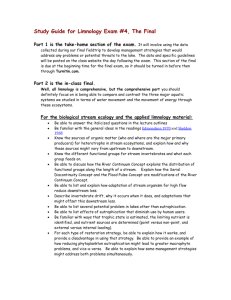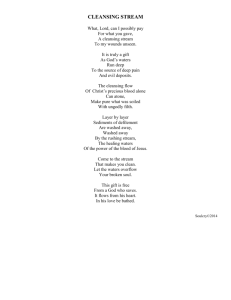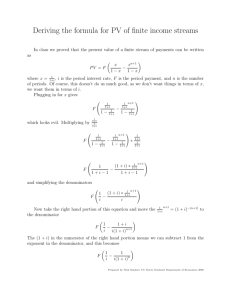Virtual Lab: Stream Ecology
advertisement

Virtual Lab: Stream Ecology Username: fbms1student *you do not need a password. Name: ____________________ Science A B Answer the questions in “A Balanced Ecosystem” before starting the simulation. A Balanced Ecosystem 1. List 6 factors that affect the balance of an aquatic ecosystem. 2. What are some types of pollutants you may expect to find in a stream? 3. What does “organic” mean? 4. What happens to sewage and other organic waste that humans dump into streams? 5. What happens when microorganisms break down organic pollutants? Is this a good thing or a bad thing? Why (what happens)? 6. How can streams recover their health after being exposed to organic pollutants? 7. What is “reaeration” and how is it accomplished in streams? Part I: Exploring the Simulation A. Observe the virtual stream and note the conditions as you answer the following questions. 1. In which direction (left-to-right or right-to-left) does the stream flow? Is the portion of the stream at the extreme left considered to be upstream or downstream? (By definition, water flows from upstream to downstream.) 2. What is the temperature of the water in the stream? 3. What is the depth of the stream? 4. What is the velocity of the stream? B. Find the outlet pipe from the farm/power plant/city. This outlet is the point where the selected pollutant enters the stream. In the exercises that follow it will be referred to as the pollutant source or simply as the source. Notice that you can take samples up to 500,000 m (500 Km) downstream from the source. C. Slide the Sensor along the stream to the left (upstream) and to the right (downstream) and observe the Results panel. 5. What is the distance value at the source? 6. What happens to the distance values as you move upstream from the source? 7. Do the distance values increase or decrease as you move downstream from the source? Part II: Establish the Baseline Conditions D. Using the Sensor, sample the non-polluted stream at the farm/power plant/city by positioning the Sensor so that the distance equals 0 x 1000 m. 8. Record the values for temperature and dissolved O2 in the 0 row on the left side of Table 1 on the Data Sheet. 9. Indicate the species found by placing an "X" in the appropriate boxes in Table 1. E. Without modifying the stream conditions, sample the stream water. Slide the Sensor to the left or to the right to collect samples. 10. Complete the left side of Table 1 by sampling each of the indicated locations downstream of the pollution source and one location upstream. Part III: Effects of a Pollutant on the Stream G. Use the drop-down menus in the Select a Pollutant panel to select Animal Waste and a Volume(pollutant):Volume(stream) ratio of 1:500. H. Sample the water at the source, at each of the indicated distances downstream and one location upstream of the pollution source, as indicated in Table 1. Record your answers to questions 11 and 12 on the right side of Table 1. 11. Record the values for temperature and dissolved O2. 12. Indicate the species found by placing an "X" in the appropriate boxes. I. Consider the entire stream as you answer the following questions. 13. Did the pollutant affect the temperature, dissolved O2, or both? Explain. 14. Were the species that inhabit the stream affected by the pollutant? In other words, did some species disappear or did new species appear? Explain. 15. Did the pollutant affect the entire stream or were the effects confined to a small area? Explain. Part IV: Pollution Scenarios Complete the first scenario (you may do others on a separate sheet if you have time) *be sure to read the scenario description under “Data & Observations *Read the graphing guidelines under “Analysis & Conclusions” Scenario 1: To grow or not to grow? Effects of Pollution on a Stream Refer to Table 1 and Graph 1 as you answer the following questions: 1. Why was it important to determine the baseline conditions before assessing the effects of the pollutants on the stream? 2. Describe the shapes of the dissolved O2 and temperature curves for the non-polluted stream. 3. Describe the shapes of the dissolved O2 and temperature curves for the polluted stream. 4. Compare the dissolved O2 curves for the non-polluted and polluted streams. Describe any similarities or differences. 5. Compare the temperature curves for the non-polluted and polluted streams. Describe any similarities or differences. 6. Describe any changes in the types and location of species living in the non-polluted stream. 7. Describe any changes in the types and location of species living in the polluted stream. How do they differ from the non-polluted stream? 8. Based on your data, answer why different species survive in some locations but not others. Cite specific examples. Name organisms and the conditions under which they appear or disappear. 9. Based on your data, identify species that, by their presence or by their absence, may serve as indicators of polluted water. 10. What was the minimum distance needed for the stream conditions and species composition to return to normal? Analysis of Different Pollution 11. Describe the dissolved O2 curves produced by the raw sewage and the treated sewage. 12. Which pollutant had the greater effect on dissolved O2? 13. How were the species affected by the different pollutants? How do these effects compare with the results seen in the non-polluted stream? 14. Does the raw sewage affect the stream significantly? Explain. 15. Should the council be concerned about increased pollution? Applying What You Learned Rainwater and other runoff that results from people watering their lawns and gardens or washing their cars is carried away by storm sewers that run beneath the streets in many cities and towns. Imagine that you live in a town where all of the storm sewers drain into a stream that runs through the park at the center of town. The members of the local environmental club are worried that the stream is being harmed by pollution in the runoff. Knowing that you have recently studied stream ecology, the members ask you to help them evaluate the health of the stream. How you would evaluate the health of the stream? 33. Describe how you would determine whether or not the stream was being significantly affected by the runoff. 34. List specific examples of the types of organisms you might expect to see in a healthy stream. 35. List specific examples of the types of organisms you might expect to see in a polluted stream.








